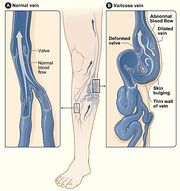SteveHFisyh (talk | contribs) (Add links and picture) |
Charmingskin (talk | contribs) m (Link to other webpage) Tags: Visual edit apiedit |
||
| (One intermediate revision by one other user not shown) | |||
| Line 4: | Line 4: | ||
|type=Vascular damage |
|type=Vascular damage |
||
|cause=Reverse pressure on the veins, often caused by prolonged standing in one place |
|cause=Reverse pressure on the veins, often caused by prolonged standing in one place |
||
| − | |symptom=Notably swollen [[ |
+ | |symptom=Notably swollen [[veins]] protruding from the [[skin]], [[pain]] in the effected area |
|mortalityrate=Low, but numerous complications such as continued loss of [[muscles|muscle]] tone. |
|mortalityrate=Low, but numerous complications such as continued loss of [[muscles|muscle]] tone. |
||
|treatment=[[Surgery]] |
|treatment=[[Surgery]] |
||
| Line 12: | Line 12: | ||
| − | A '''varicose vein''' is a [[Veins|vein]] that has become inflamed and swollen as the result of the breakdown |
+ | A '''varicose vein''' is a [[Veins|vein]] that has become inflamed and swollen as the result of the breakdown of the valves that otherwise prevent [[blood]] in the veins from flowing away from the heart. A varicose vein in the anus is a [[hemorrhoid]]. |
| − | As [[blood pressure]] is lost in the [[capillary|capillaries]], blood only moves through the veins through peristaltic movements - the squeezing of veins through muscular action (this type of pressure also causes movement of fluids through the [[lymphatic system]] and food through the [[small intestine]]). To prevent blood from flowing the wrong way through veins, there are one-way valves that prevent blood from flowing away from the heart.[[File: |
+ | As [[blood pressure]] is lost in the [[capillary|capillaries]], blood only moves through the veins through peristaltic movements - the squeezing of veins through muscular action (this type of pressure also causes movement of fluids through the [[lymphatic system]] and food through the [[small intestine]]). To prevent blood from flowing the wrong way through veins, there are one-way valves that prevent blood from flowing away from the heart.[[File:Varicose veins.jpg|thumb|left|Diagram of a varicose vein, courtesy NIH, via Wikipedia]] |
However, when muscles are not used and blood must flow against the force of gravity, the valves often are destroyed. This is common in occupations that require standing without movement for long periods of time. As a result, blood has a harder time moving through the veins, causing inflammation, swelling and fatigue as it becomes more difficult to return blood to the [[heart]]. |
However, when muscles are not used and blood must flow against the force of gravity, the valves often are destroyed. This is common in occupations that require standing without movement for long periods of time. As a result, blood has a harder time moving through the veins, causing inflammation, swelling and fatigue as it becomes more difficult to return blood to the [[heart]]. |
||
| − | Varicose veins are permanent. Treatment usually starts with the use of compression stockings to support the vein. However, if those do not work, drug therapies can be tried. After that, the only treatment is to block or remove the vein. In most cases, this will not affect the patient as the flow of blood through veins is usually redundant in most parts of the body. |
+ | [http://charmingskin.com/varicose-vein-laser-treatment/ Varicose veins] are permanent. Treatment usually starts with the use of compression stockings to support the vein. However, if those do not work, drug therapies can be tried. After that, the only treatment is to block or remove the vein. In most cases, this will not affect the patient as the flow of blood through veins is usually redundant in most parts of the body. |
[http://www.ncbi.nlm.nih.gov/pubmedhealth/PMH0002099/ Varicose veins at NIH] |
[http://www.ncbi.nlm.nih.gov/pubmedhealth/PMH0002099/ Varicose veins at NIH] |
||
| Line 25: | Line 25: | ||
[http://www.mayoclinic.com/health/varicose-veins/DS00256 Varicose veins at Mayo Clinic] |
[http://www.mayoclinic.com/health/varicose-veins/DS00256 Varicose veins at Mayo Clinic] |
||
| − | [[Category:Diseases| |
+ | [[Category:Diseases|Varicose veins]] |
Revision as of 06:35, 1 July 2015
A varicose vein is a vein that has become inflamed and swollen as the result of the breakdown of the valves that otherwise prevent blood in the veins from flowing away from the heart. A varicose vein in the anus is a hemorrhoid.
As blood pressure is lost in the capillaries, blood only moves through the veins through peristaltic movements - the squeezing of veins through muscular action (this type of pressure also causes movement of fluids through the lymphatic system and food through the small intestine). To prevent blood from flowing the wrong way through veins, there are one-way valves that prevent blood from flowing away from the heart.

Diagram of a varicose vein, courtesy NIH, via Wikipedia
However, when muscles are not used and blood must flow against the force of gravity, the valves often are destroyed. This is common in occupations that require standing without movement for long periods of time. As a result, blood has a harder time moving through the veins, causing inflammation, swelling and fatigue as it becomes more difficult to return blood to the heart.
Varicose veins are permanent. Treatment usually starts with the use of compression stockings to support the vein. However, if those do not work, drug therapies can be tried. After that, the only treatment is to block or remove the vein. In most cases, this will not affect the patient as the flow of blood through veins is usually redundant in most parts of the body.
